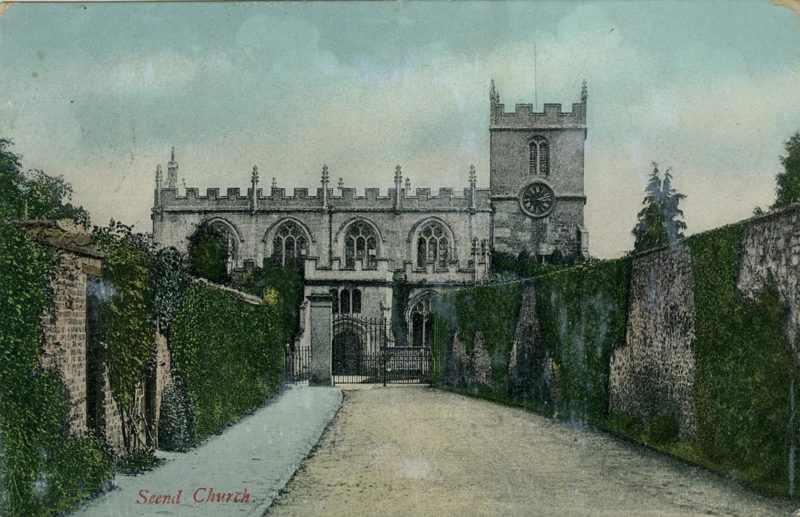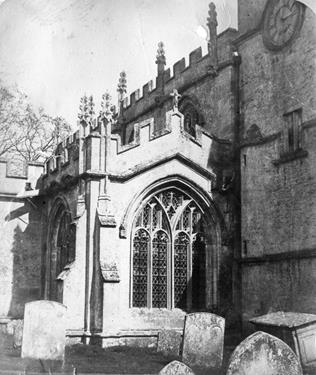Student volunteer Anna takes a look at Holy Cross Church in Seend...
Holy Cross Church, is a Grade 1 listed church (in 1962), funded by John Stokys and dating from around 1450 with Norman remains to the low west tower. It is the main parish church for Seend village with a rich history. It is built with rubble stone and faced with ashlar.
Parchments found about the church give us a general idea of the church around the time of 1500 and the sources in Devizes Museum acrives bring much of it to life. The north aisle (DZSWS:2017.7038) and attached battlemented entrance porch (DZSWS:1985.7366) were also added after the original build but by the original architect. He incorporated a stone crucifix (DZSWS:1986.7224) and cloth merchant’s tools (DZSWS:1985.8283 and DZSWS:1985.8285) which reflect how the village became wealthy at the time, through the wool trade. Additionally the church had a number of gargoyles (DZSWS:1985.7369) which, if slightly worn, are still visible today and an anthropophagus (DZSWS:1985.8284). By 1553, the church tower had three bells fitted. The font, depicted in (DZSWS:2017.5001) dates from (c.1450). It was removed from the church and used as a garden ornament but restored to its rightful home in 1938.
There is a mysterious shadow in the shape of a cross above the archway of the nave. Whilst image (DZSWS:1985.8816) shows the archway strangely, it does not show the shadow that can be seen there today. It is thought that it was a figure of Jesus on the cross which survived the English Reformation during the 16th and 17th centuries, but may have been removed to protect the church. However, there are debates on whether this is accurate or not, with other people believing that the shadow was a wall painting of the Crucifixion. Whilst today we are familiar with fairly plain walls in churches, pre-reformation they were often elaborately painted, so this is a possibility.
The Civil War of the 17th century resulted in many registers from Baptisms, Marriages and Deaths not being recorded between 1645 and 1651, alongside stained glass windows being broken and taken down in 1648 by William Sumner. However, despite these effects of the Civil War, there was no major disruption and destruction of the church. This is quite remarkable given a major battle at Roundway, just five miles from the village, in 1643.
After the Civil War, during the mid-18th century, there were several restorations to help encourage Sunday service attendance. Changes included the installation of pews which were bought and sold with the houses they were owned by (a list of the seats and owners in 1729 gives evidence for this, although it is not held by the museum). A new aisle and gallery on the south side of the church in 1726 (DZSWS:1985.8815) were added to help with the growing congregation and a further gallery was installed in 1797 to accommodate the children attending Sunday School.
As with the font (mentioned above) the original pulpit was also removed, but the wooden one was replaced with a stone one (created by Nathaniel Hitch in 1884) and installed Thynne with money left as a bequest to the church. Canon Thynne instigated a number of changes in the 19th century. He increased the number of services being held in the church and raised money to improve the interior. Whilst motives were questioned and improvements took longer than he hoped, eventually much remodelling was done, including the opening of the tower arch and resiting of the organ to a gallery in 1889. The bell tower by now housed six bells dating from 1553, 1636, 1793 and 1880. He oversaw the rebuilding of the chancel in 1875 also the removal of the original pine pews (still found in houses and establishments in the village), replacing them with oak. Much stained glass was added replacing the plain windows added in the 17th century. Annual reports show it was Thynne who introduced the ornate and decorative brass candlesticks in the pews and aisles (DZSWS:1983.7892, DZSWS:1983.7893, DZSWS:1982.6124 and DZSWS:1985.8816). The countless memorials on the walls (DZSWS:MSS.1438) would have also been introduced around this time, including brasses to Stoyks and his wife.
In addition to the history of the architecture of the church, Holy Cross was known as one of the main providers of relief for the sick and poor of the area, raising its own poor rate (tax on property) in 1734. Whilst there are no records of this from the 16th century, there is evidence of the church dividing the tithes into several parts, one of which being for the poor and farmers and households paying one tenth of their income to the church. This income for the church helped with providing food and shelter for the poor. There is evidence of William Tipper leaving £50 within his will to the wardens of the church, asking it to be used for the ‘poor people of Seend’. This was invested and used to purchase blankets and food for the poor and old people of the village. Known as ‘Bugge Coats’, they were handed out as Christmas. This support continued until 1906. One man in particular influenced this: Thomas Bruges (1835), who helped in the distribution of blankets during Christmas.
Holy Cross is accessed by ‘Church Walk’ (DZSWS:1982.6095, DZSWS:2001.5381) off of the main village road. At the end of the walk are gates providing access to the church yard and path to the north door (DZSWS:1985.7368). The war memorial cross is situated near the gates of the church (DZSWS:2001.5382). Holy Cross sits in a church yard. The south side (DZSWS:1985.8815, DZSWS:1982.6126) provides views across the valley.
Regular services continue to held at Holy Cross. Pews remain in the majority of the church, although alterations have taken place to ensure the church remains a relevant and focal point for the village. One of the most recent installations was the millennium window, created by Andrew Taylor and depicting village scenes and history.
Written and research by Anna Hallett




